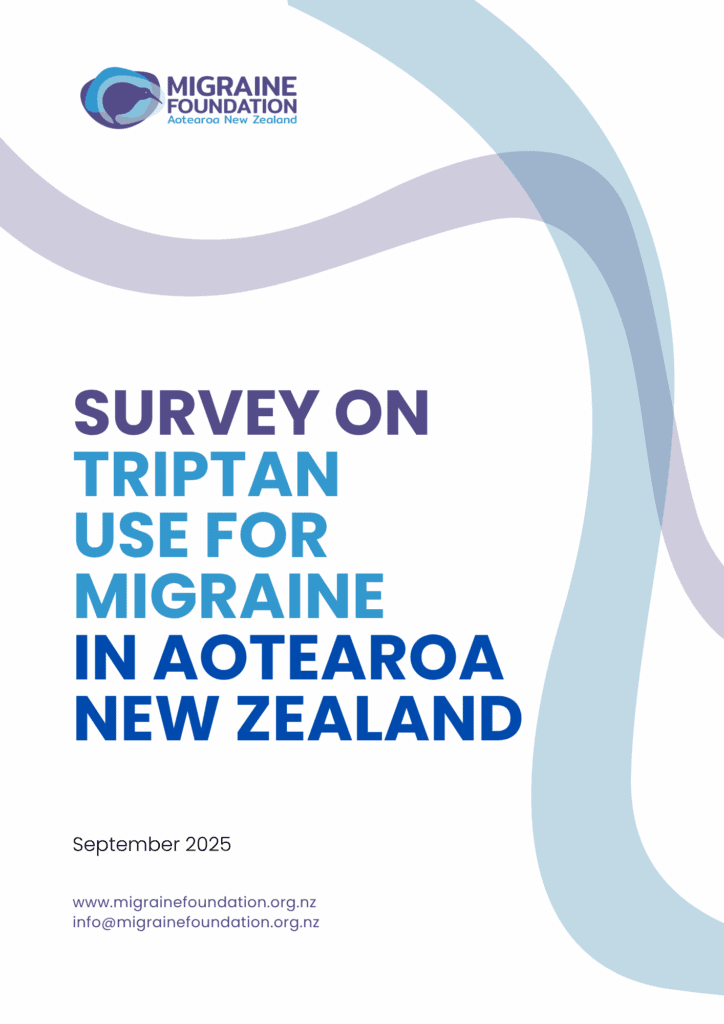Triptan use in NZ: Report

Survey on triptan use for migraine in Aotearoa NZ
The survey invited participation from adults (18 years and over) with migraine who live in NZ and had been diagnosed with migraine or had symptoms consistent with migraine.
We received 611 complete responses. Responses were anonymous with no identifying information collected.
Why the research is important
Compared to most other OECD countries, people with migraine in NZ have limited access to migraine treatment options.
As of August 2025, none of the new migraine-specific preventive medications are funded (e.g. galcanezumab, atogepant) and none of the new migraine-specific acute treatments are available in NZ (e.g. rimegepant, ubrogepant, lasmiditan).
Even for the old migraine-specific acute treatments, the triptans, which were developed in the 1990s, only two are available in NZ, compared to seven available worldwide.
Summary of findings
- On average, respondents reported having a headache on 11 days a month. Around a third of respondents had headache on 15 or more days a month.
- NSAIDs, triptans and paracetamol were the most commonly used acute medications.
- Use of injectable sumatriptan was low, despite this being recommended for people with migraine who have nausea and vomiting or don’t respond well to oral triptans.
- Nearly a quarter of respondents had taken opioids within the last month for migraine. This is significant as opioids are not recommended for migraine.
- Over one third reported they’d tried at least one triptan but it didn’t work or stopped working. Rebound and medication overuse headache were noted as issues that meant people had to stop or limit triptan use.
- The most common reasons people had stopped using triptans were that they didn’t work or had stopped working or due to side effects.
- Nearly one in ten respondents hadn’t been offered or prescribed triptans by a health professional, despite these being first-line migraine treatments.
- Two thirds wanted to try at least one other type of triptan, particularly a nasal spray option, which could work for those with nausea and vomiting, and a triptan that could be effective in treating menstrual migraine.
In the words of survey participants
“I’ve tried all triptans in this survey and now travel to Australia to get Naramig. Previous to Naramig most migraines were initially treated with injection sumatriptan and then treated in hospital with IV chlorpromazine. Naramig is excellent if taken within 30 minutes or so of onset. [Travelling to Australia] is now a huge expense but I don’t want to go back to hospital treatments of migraines. My heart breaks for all the people who can’t access this medication, can’t afford to travel to Australia and have no quality of life.” (34–44 year old NZ European female)
“The treatments for migraine in NZ are extremely limited and the ones that aren’t funded are VERY expensive, and inaccessible for people who are unable to work, or are students etc. This is extremely unfair and upsetting. Myself and others shouldn’t be forced to “live/deal” with unbearable pain that affects our/my day-to-day life and every aspect of it.” (18–24 year old NZ European male)
“I suffer menstrual migraine (as well as other migraine) and have not been able to get relief from other triptans for this.” (45–54 year old NZ European female)
“When I lived in the States, I used Ubrelvy (which worked perfectly!), it would be awesome if this could be available here.” (35–44 year old Māori female)
“I was only ever offered rizamelt – this drug never worked at all. I have never been offered any alternative – I have asked multiple times.” (18–24 year old NZ European male)
“Would manage headache with nurofen and panadol & often just rested/withdrew. Never pushed/was aware of better treatment. Even ended up in hospital from dehydration due to vomiting from migraine but not offered alternative treatment.” (65+ year old NZ European female)


